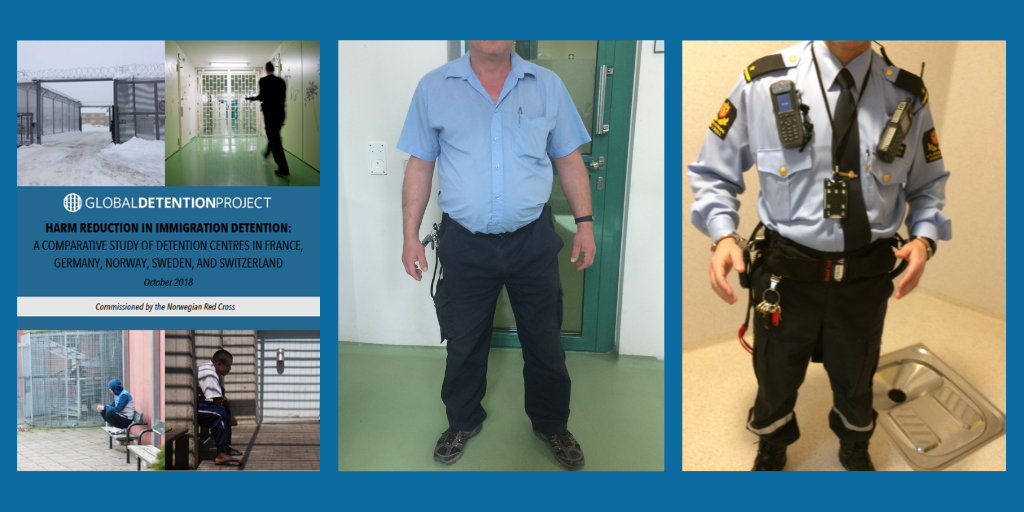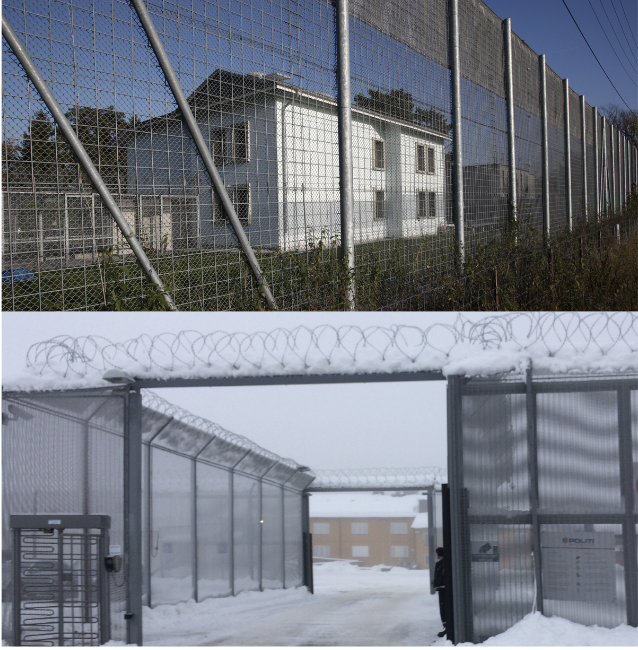In May, the Global Detention Project (GDP) assisted an official delegation from Norway’s Ministry of Justice in visiting the Frambois Detention Centre in Geneva, Switzerland. The delegation was comprised of members of the Norwegian Supervisory Board for Forced Deportations and Immigration Detention, which monitors operations at the Trandum immigration detention centre, located near Oslo.
The Board, led by Appeals Court Justice Pål Morten Andreassen, was interested in visiting Frambois based on recommendations the GDP made in our 2018 report, “Harm Reduction in Immigration Detention: A Comparative Study of Detention Centres in France, Germany, Norway, Sweden, and Switzerland.” The Norwegian Red Cross had commissioned the GDP to produce this report in order to assist in the promotion of practices that could reduce harms caused by immigration detention. Since it was published, numerous recommendations in the report have been reflected in reform agendas adopted by civil society groups as well as the Ministry of Justice’s Supervisory Board.
A key point of interest for the Supervisory Board was the report’s comparison of Frambois’s relatively humane detention regime to the highly securitised Trandum facility, which has been the focus of intense scrutiny in Norway due its management by a special police unit and numerous incidents of violence. The Frambois facility, officially called the Frambois Certified Establishment for Administrative Detention (Etablissement Concordataire de Détention Administrative de Frambois), is operated by a non-governmental foundation established by several Swiss cantons for the purpose of detaining migrants who are in deportation procedures. Although operations at Frambois have been criticised, including the sometimes lengthy periods of time that people can remain detained there, the facility is well known in Switzerland for having much less harsh and punitive practices than those at other detention facilities in the country. The centre was also the subject of an award-winning 2011 documentary Vol special (“Special flight”), which garnered critical acclaim for its intimate portrait of the daily lives of detainees at Frambois facing forced deportations.
Based on a careful review of operations at Frambois, as well as at several other detention centres across Europe, the GDP proposed a number of harm-reducing reforms to be considered by the Norwegian Red Cross in its advocacy concerning Trandum. A key proposal was to remove the special police unit from Trandum, which has a militaristic style in both its operations and appearance, and instead place the facility under the responsibility of a social welfare agency, which the GDP observed at other detention centres, including at Germany’s Ingelheim detention centre. The report also highlighted numerous practices at Frambois that could help prevent harms and reduce tensions at Trandum, including allowing detainees to prepare their own meals, encouraging interactions between staff and detainees, and expanding activities for detainees.
The Supervisory Board was interested in seeing first-hand many of these practices, and thus they reached out to the GDP to enquire about the possibility of arranging a visit to the detention centre. The GDP then contacted Geneva’s Population and Migration Office (Office cantonal de la population et des migrations), which authorised a visit to Frambois by the Supervisory Board and GDP staff, which was led by the director of Frambois, Francesco Bruscoli, and included a full tour of the facility as well as meetings with staff members and detainees. Prior to the visit, which took place on 26 May, the GDP organised a meeting between the Supervisory Board and the local NGO that monitors Frambois, La Ligue Suisse des droits de l’homme, so that the delegation could be sensitised to key civil society concerns regarding the treatment of detainees in Geneva and elsewhere in Switzerland.
Following their visit to Frambois, the Supervisory Board wrote to the GDP to highlight key practices that they thought could serve as the basis for reforms at Trandum, including:
- Modifying the appearance of guards and staff at Trandum to appear less aggressive;
- Broadening detainee access to the internet;
- Enabling detainees to prepare their own meals;
- Encouraging interactions between staff and detainees, including sharing meals together, and in general improving the rapport between them;
- Limiting use of security cells;
- Separating deportation authorities from detention centre management (at Frambois, the management team does not play any role in the deportation process);
- Empowering staff with the ability to be flexible and make adaptations in their practices that are responsive to the needs of detainees;
- Providing meaningful and ongoing activities for detainees, like remunerative work, which are absent at Trandum.
A recurring theme during the Supervisory Board’s visit to Geneva—including in conversations with the GDP, local civil society groups, and Frambois staff—was the larger challenge of how to propose meaningful reforms for immigration detention regimes. The GDP has long argued that immigration detention represents an exceptional power that easily becomes arbitrary and harmful. Thus, in our work, we have consistently argued—including in our report “Harm Reduction in Immigration Detention”—that it is impossible to promote “best practices” in an area of public policy like immigration detention if it is inherently harmful. While recognising that even in a facility like Frambois there are challenges that need to be addressed, the Supervisory Board nevertheless concluded that for their purposes, the visit provided important ideas for how to improve the treatment of detainees in Norway.




